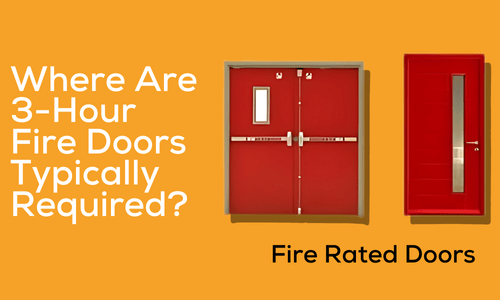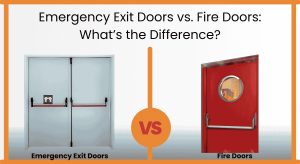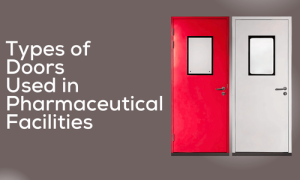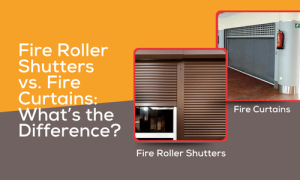Fire-rated doors play a crucial role in ensuring fire safety within buildings, especially those with complex floor plans or designated high-risk areas. Among the various fire-resistance ratings, 3-hour fire rated doors stand out for their exceptional durability and ability to withstand fire for an extended period. These doors are typically required in specific commercial, industrial, and institutional settings rather than in residential dwellings. In this blog, we’ll explain what 3-hour fire rated doors are and where they are mandated by safety codes. We’ll also highlight how these doors differ from lower-rated options and why following proper installation and regular maintenance practices is essential to maximize their effectiveness in protecting lives and property.
What is a 3-Hour Fire Rated Door?
A 3-hour Fire Rated Doors is a door that has been tested and certified to withstand exposure to fire for up to 3 hours without failing. During a fire, this door prevents flames, smoke, and heat from spreading from one area to another. Such doors are constructed using materials like steel, gypsum, and treated wood, and are typically equipped with fire-rated hardware, seals and glazing. This is one of the highest fire ratings that can generally be found, and it’s normally installed in locations where there’s a likelihood of severe fires or where there’s a need for a fire barrier to secure the structure and protect lives.
When Are 3-Hour Fire-Rated Doors Necessary?
3-hour rated doors are generally installed in areas where the fire-resistance of the surrounding wall assembly is 4 hours, as door ratings are usually 3/4 of the wall rating. According to building codes and fire safety regulations, these doors are required in the following places:
1. Industrial Facilities
Large manufacturing plants, chemical factories, power generation units, and similar industrial environments often deal with combustible materials, flammable chemicals, and high-powered machinery. These environments have a high fire risk, and therefore, fire separation between critical sections is vital.
Example: A door separating a chemical storage room from the main production floor.
Why it’s needed: To prevent the spread of intense fires, which can be catastrophic in these high-hazard facilities.
2. Boiler Rooms and Furnace Areas
Any area that houses high-temperature equipment such as boilers, furnaces, or incinerators typically requires a 3-hour fire door if the fire-resistance rating of the wall around it is 4 hours.
Example: A door between a commercial furnace room and the rest of the facility.
Why it’s needed: These areas can be the origin point for fires due to the continuous heat and potential fuel presence.
3. Utility and Mechanical Rooms in High-Rise Buildings
In high-rise buildings, especially those classified as Group I (Institutional), Group H (High-hazard), or Group S (Storage) occupancy types under building codes, utility and mechanical rooms that are fire-separated with 4-hour walls need a 3-hour door.
Example: Electrical transformer room or generator room located within a skyscraper.
Why it’s needed: To maintain structural integrity and prevent fire from reaching escape routes or essential services.
4. Hazardous Storage Areas
Rooms used for the storage of flammable or explosive materials, including certain commercial or laboratory environments, often require walls rated for 4 hours—and doors rated for 3 hours.
Example: Paint storage room or a flammable liquid storage unit in a research facility.
Why it’s needed: To contain a potential explosion or intense fire within the room and allow evacuation or fire control efforts.
5. Fire Barrier Walls Separating Major Building Sections
Sometimes buildings are divided into fire areas or fire zones to limit the spread of fire and reduce the fire load within any single area. When these zones are separated by 4-hour fire-rated walls, any door within that wall must be rated for 3 hours.
Example: Large warehouses or distribution centers divided into fire areas.
Why it’s needed: It slows down fire progression, giving firefighters more time and improving overall building safety.
Always refer to local code interpretations, as specific jurisdictions might adopt stricter requirements.
How Are 3-Hour Doors Different From Other Fire-Rated Doors?
Fire-rated doors are available in different ratings such as 20, 60, 90, and 180 minutes. Each is employed depending on how much fire protection is required.
20-minute doors are for minimal usage, such as in residential properties or small office spaces.
60- and 90-minute doors are common in commercial buildings, stairwells, or corridors, offering moderate to high protection.
3-hour fire rated doors are much stronger. They’re used in high-risk areas where walls are rated for 4 hours—like industrial plants or hazardous storage rooms. These doors are usually made of heavy-duty steel and are built to handle extreme heat for a longer time.
They’re stronger, heavier, and equipped with special fire-resistant hardware. In short, they provide maximum protection where it’s needed most.
Importance of Proper Installation and Maintenance
- Certified doors are not sufficient – A 3-hour fire rated door needs to be installed and maintained correctly in order to function properly during an emergency.
- Gaps around the door – Incorrect fitting or alignment can create minute gaps, enabling smoke, heat, and fire to travel rapidly.
- Incorrect or missing hardware – Fire doors utilize special fire rated hardware (like hinges, closers, and latches). Non-compliant hardware can lead to code problems and reduce fire-resistance rating.
- Regular checks are necessary – Fire doors need to be checked at least once every year, or more frequently where they are subject to heavy usage to guarantee that they operate correctly.
- No propping open – Fire doors need to remain closed, or possess automatic closing mechanisms. Leaving them open prevents them from containing a fire.
- Automatic closers – These devices assist in making sure the door closes automatically in case of a fire so that smoke, and flame do not spread.
- Damage or wear must be addressed immediately – Any visible signs of damage, broken seals, or malfunctioning parts should be repaired or replaced right away.
Conclusion
3-hour fire rated doors are not for everyday use—they are critical life safety components designed for high-risk environments. Used in locations such as industrial facilities, boiler rooms, dangerous storage facilities and utility rooms, these doors are a critical barrier that can help to save property and lives by impeding the passage of ferocious fires. Building managers, facility owners and contractors need to know where these doors are needed and ensure they meet code requirements, are installed correctly, and inspected regularly.





